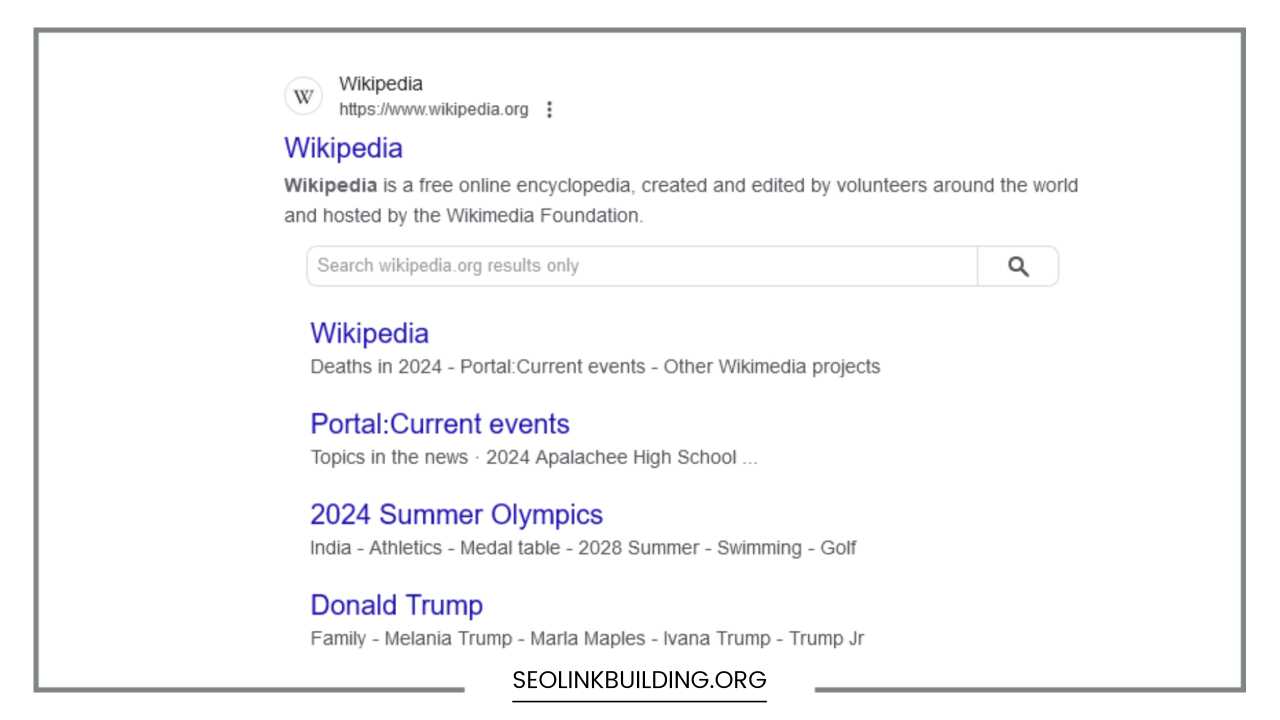What Are Sitelinks, Their Benefits, & How to Influence Them

What Are Sitelinks
An In-Depth Exploration of Sitelinks: Enhancing User Experience and Visibility
In the constantly evolving world of search engine optimization (SEO) and digital marketing, understanding and optimizing sitelinks can significantly impact your website’s performance and user experience.
This comprehensive guide will delve into the concept of sitelinks, their benefits, and actionable strategies for influencing their appearance to enhance your site’s visibility and user engagement.
What Are Sitelinks?
Sitelinks are supplementary links displayed beneath a website’s main search result on Google. These links provide users with direct access to specific pages within a website, offering more precise navigation beyond the primary homepage or landing page. They are designed to improve user experience by simplifying access to important sections of a site.
Types of Sitelinks
- Organic Sitelinks: These are automatically generated by Google’s algorithms based on the site’s structure and content relevance. Organic sitelinks appear below the main search result in the natural search results section. They are not manually chosen or controlled by the website owner but are influenced by the website’s organization and internal linking.
- Paid Search Sitelinks: These are part of Google Ads and are manually configured by advertisers. Paid search sitelinks appear within sponsored search results and allow advertisers to include additional links to various pages of their site. Unlike organic sitelinks, these are directly controlled by the advertiser and can be customized to enhance ad performance.
Benefits of Sitelinks
Understanding the benefits of sitelinks can help you appreciate their value and the importance of optimizing them effectively. Here are the primary advantages:
1. Improved User Experience
Sitelinks enhance user experience by offering direct access to specific sections of a website. This feature is particularly valuable for users navigating complex sites or seeking particular information quickly.
For instance, if a user searches for “best running shoes” and your site appears with sitelinks to product categories, reviews, and contact information, they can easily find what they need without unnecessary clicks.
- Efficient Navigation: By reducing the number of clicks required to reach a desired page, sitelinks streamline navigation and improve overall site usability.
- Enhanced Accessibility: Users can bypass intermediary pages and access relevant content directly, making their search experience more efficient.
2. Increased Click-Through Rate (CTR)
The presence of sitelinks can significantly increase your CTR. When users see multiple links below your main search result, they perceive your site as more relevant and informative. This perception often leads to a higher likelihood of clicking on your result over others without sitelinks.
- Visual Appeal: Sitelinks make your search result stand out more prominently on the SERP, attracting more attention.
- Perceived Relevance: Users are more likely to click on a result that appears comprehensive and well-organized, as sitelinks provide immediate access to relevant content.
3. Enhanced Brand Visibility
Sitelinks can improve your brand’s visibility by occupying additional space on the search results page. This increased visibility helps to establish your brand identity and distinguish it from competitors.
- Increased SERP Real Estate: By displaying multiple links, you occupy more space on the search results page, making your listing more prominent.
- Brand Reinforcement: Multiple sitelinks can reinforce your brand’s message and presence, making it easier for users to recognize and remember your brand.
4. Improved SEO Performance
Although sitelinks themselves do not directly influence your search engine ranking, they can contribute to improved SEO performance indirectly.
A higher CTR and enhanced user engagement, driven by effective sitelinks, can signal to Google that your site is relevant and valuable.
- User Engagement Metrics: Increased CTR and reduced bounce rates can signal to Google that users find your site relevant and useful.
- Long-Term SEO Benefits: Positive user behavior resulting from effective sitelinks can contribute to improved search rankings over time.
How to Influence Sitelinks
While Google’s algorithm ultimately determines which sitelinks appear for a given search query, several strategies can increase the likelihood of your site displaying sitelinks. Implementing these strategies can enhance your site’s structure, content, and overall relevance.
1. Create a Strong Site Structure
A well-organized site structure is fundamental for generating sitelinks. Ensure your website is logically organized, with clear navigation paths and a hierarchical structure.
This helps both users and search engines understand the relationship between different pages.
- Organize Content into Categories: Group related content into categories and subcategories. This hierarchical organization makes it easier for search engines to identify key pages.
- Use Descriptive Page Titles and Meta Descriptions: Craft clear and descriptive titles and meta descriptions for your pages. These elements help search engines understand the content and relevance of your pages, influencing sitelink selection.
2. Optimize Internal Linking
Internal linking helps establish relationships between different pages on your site. By creating a network of links, you improve site navigation and assist search engines in understanding the context and importance of various pages.
- Link Relevant Pages: Ensure that pages are linked to other relevant pages within your site. This enhances the visibility of important content and aids in sitelink generation.
- Use Descriptive Anchor Text: Use descriptive and relevant anchor text for internal links. This practice helps search engines and users understand the content of the linked pages.
3. Build High-Quality Backlinks
Backlinks from reputable and relevant websites enhance your site’s authority and relevance. These external endorsements can influence the likelihood of your site being chosen for sitelinks.
- Focus on Quality: Prioritize obtaining backlinks from high-authority sites within your industry. Quality backlinks are more valuable than a high volume of low-quality links.
- Diversify Link Sources: Build backlinks from a variety of sources to create a robust link profile. A diverse set of backlinks can enhance your site’s credibility and visibility.
4. Utilize Google Search Console
Google Search Console is a powerful tool for monitoring and optimizing your sitelinks. It provides insights into how your site appears in search results and can help you identify and address issues related to sitelinks.
- View Existing Sitelinks: Use Google Search Console to see which sitelinks are currently displayed for your site. Assess their relevance and effectiveness.
- Identify and Resolve Issues: Address any issues that may prevent sitelinks from appearing, such as broken links or incorrect metadata.
5. Create High-Quality Content
Google is more likely to display sitelinks for websites with high-quality, relevant content. Focus on creating content that is valuable, engaging, and useful to your target audience.
- Ensure Relevance: Produce content that addresses the needs and interests of your target audience. Relevant content is more likely to be chosen for sitelinks.
- Engage Users: Write engaging content that captures user interest and encourages longer visits. High-quality content can lead to better user engagement and improved sitelink performance.
6. Experiment with Different Sitelink Configurations
Experimentation can help you determine which sitelink configurations work best for your site. Try different approaches to see which configurations drive the most traffic and engagement.
- Category-Based Sitelinks: Create sitelinks for major content categories to facilitate navigation and improve user access.
- Landing Page Sitelinks: Test sitelinks for specific landing pages to drive targeted traffic and enhance user experience.
Additional Tips for Sitelink Optimization
Optimizing sitelinks involves ongoing maintenance and monitoring to ensure they remain effective and relevant. Here are additional tips to enhance your sitelink strategy:
1. Keep Your Sitelinks Up-to-Date
Regularly review and update your sitelinks to ensure they remain accurate and relevant. Outdated or incorrect sitelinks can negatively impact user experience and reduce their effectiveness.
- Review Periodically: Set a schedule for reviewing your sitelinks to ensure they align with current content and site structure.
- Update as Needed: Make updates to sitelinks when there are significant changes to your site’s content or structure.
2. Monitor Sitelink Performance
Track the performance of your sitelinks using analytics tools to assess their effectiveness. Monitoring performance metrics can help you understand which sitelinks drive the most traffic and engagement.
- Use Google Analytics: Monitor key metrics such as click-through rates, bounce rates, and user engagement for your sitelinks.
- Analyze Trends: Look for trends in sitelink performance to identify which configurations are most effective and make data-driven improvements.
3. Consider Sitelink Extensions for Paid Search Ads
If you run paid search campaigns, utilize sitelink extensions to enhance your ads. Sitelink extensions allow you to add additional links to your ads, providing users with more options and potentially improving ad performance.
- Create Relevant Extensions: Add sitelink extensions that are relevant to your ad’s content and objectives. Ensure that they provide valuable options for users.
- Monitor Ad Performance: Track the performance of sitelink extensions in your paid search campaigns to assess their impact and optimize as needed.
Final Thoughts
Sitelinks are a valuable feature in search engine results pages that can significantly impact user experience, brand visibility, and website performance.
While the appearance of sitelinks is ultimately determined by Google’s algorithms, adopting strategic practices can enhance your chances of displaying sitelinks and optimizing their effectiveness.
By focusing on creating a strong site structure, optimizing internal linking, building high-quality backlinks, and producing engaging content, you can influence sitelink generation and improve your site’s visibility and user experience. Regular monitoring and updates will help ensure that your sitelinks remain relevant and effective.
Incorporating these strategies into your SEO and digital marketing efforts will not only help you leverage the benefits of sitelinks but also contribute to your overall online success.
As search engine algorithms and user behaviors continue to evolve, staying informed and adaptable will be key to maintaining and enhancing your online presence.













